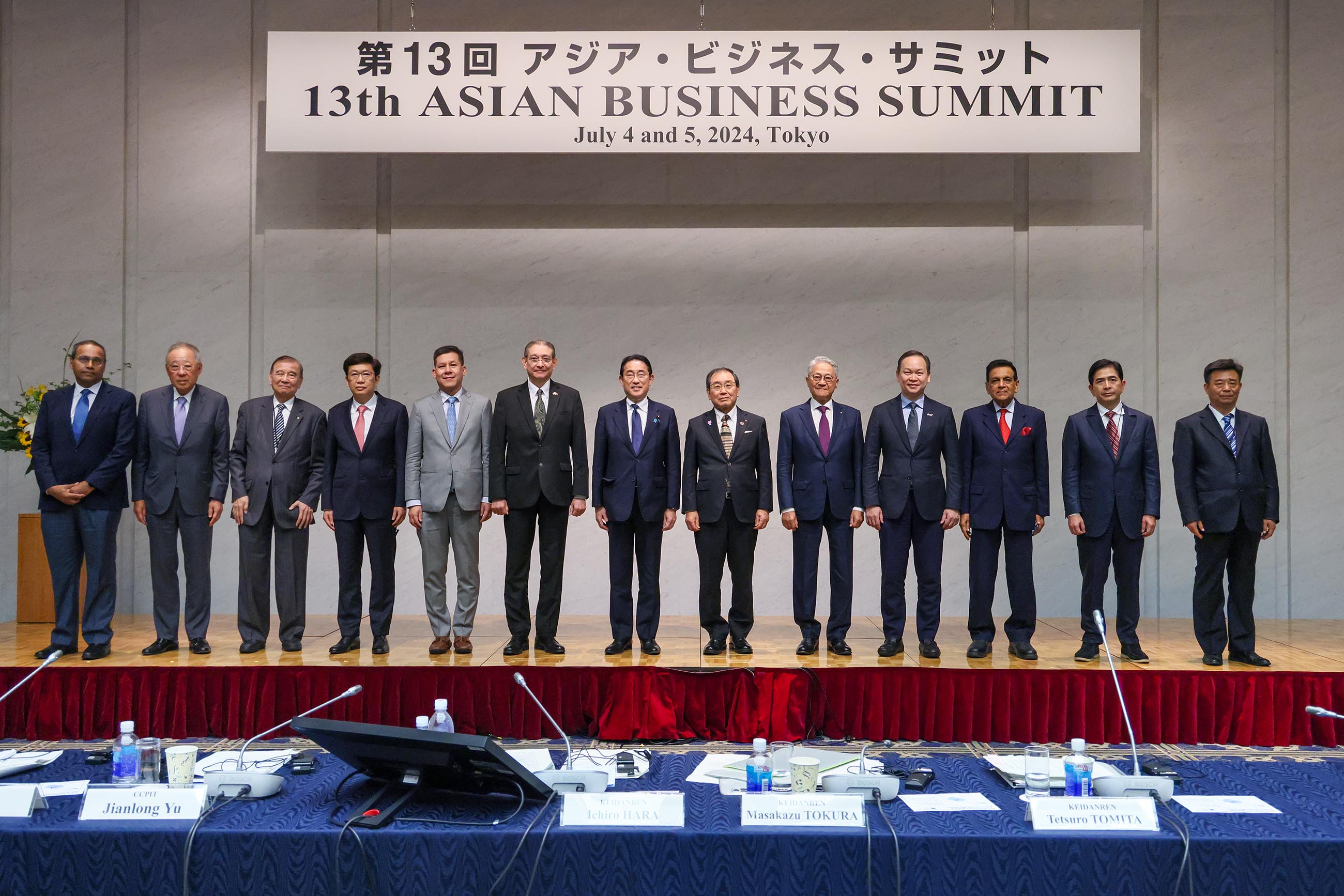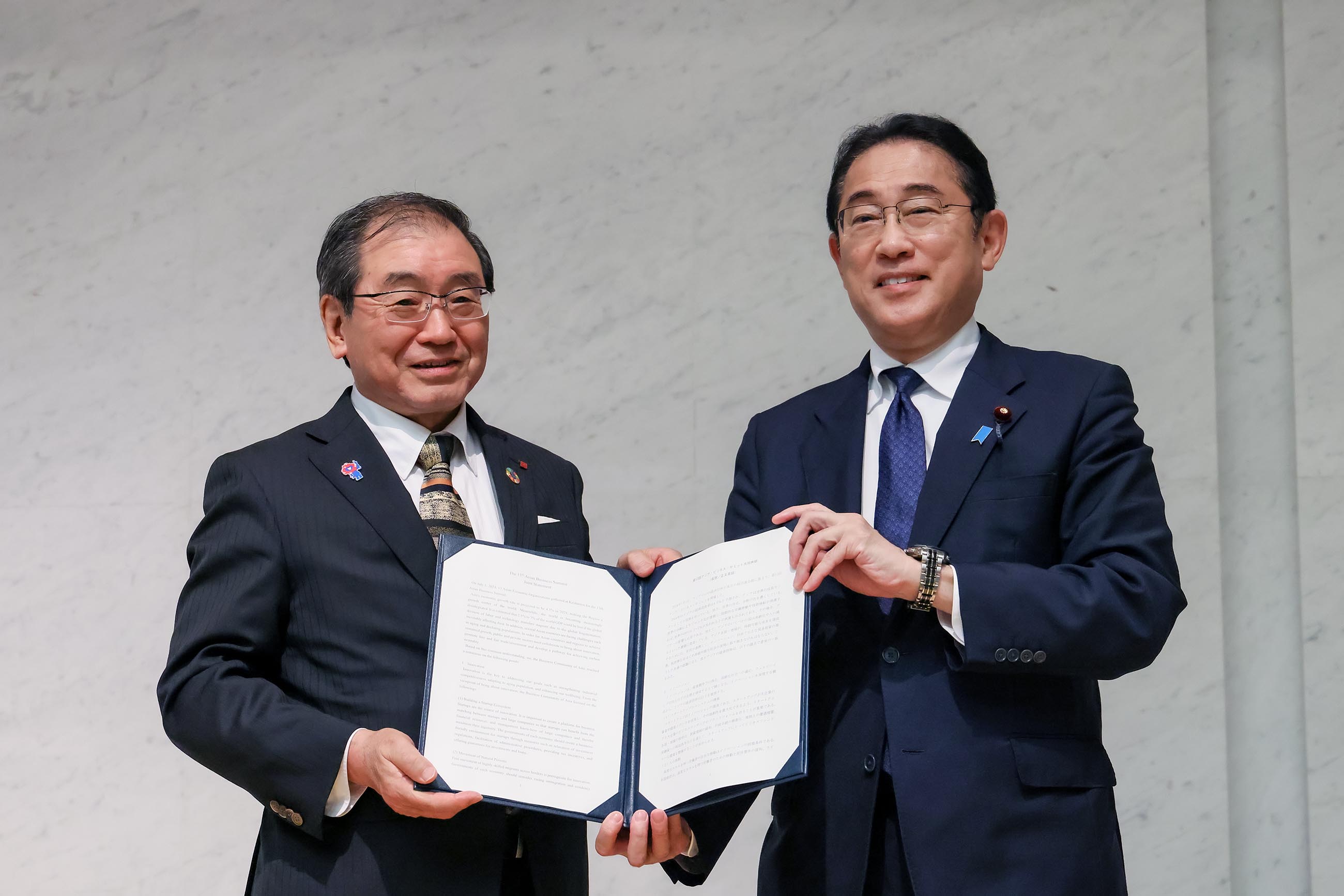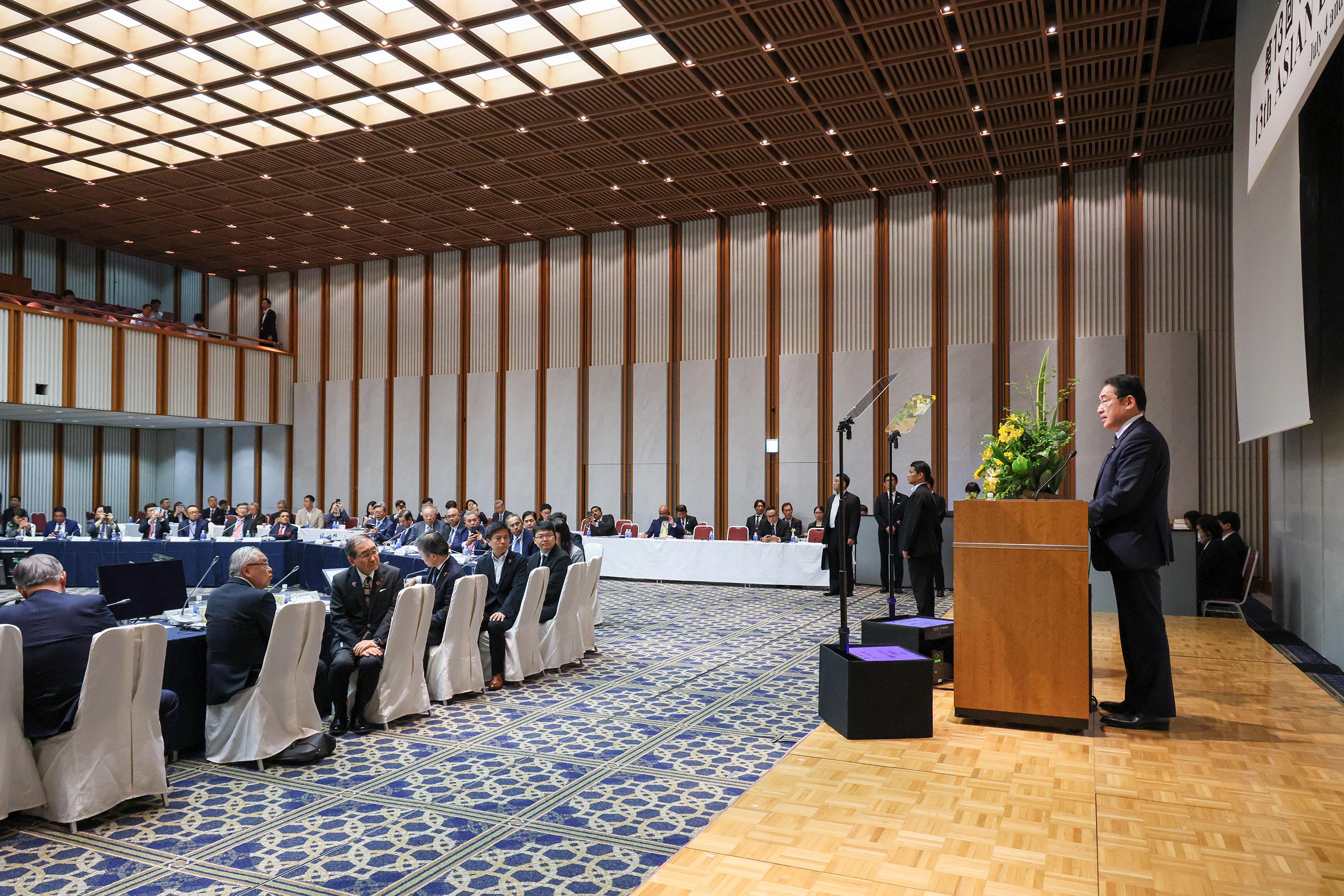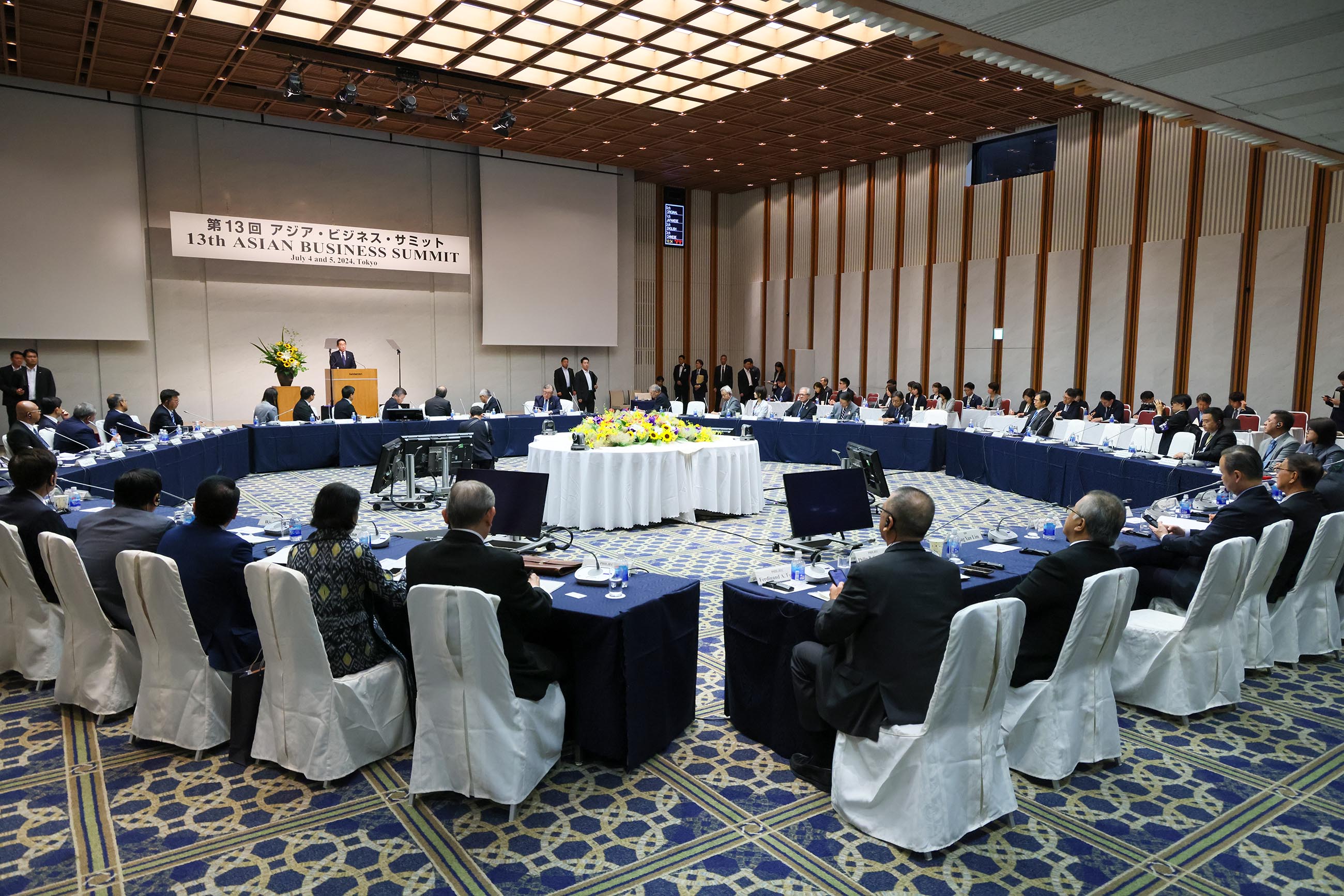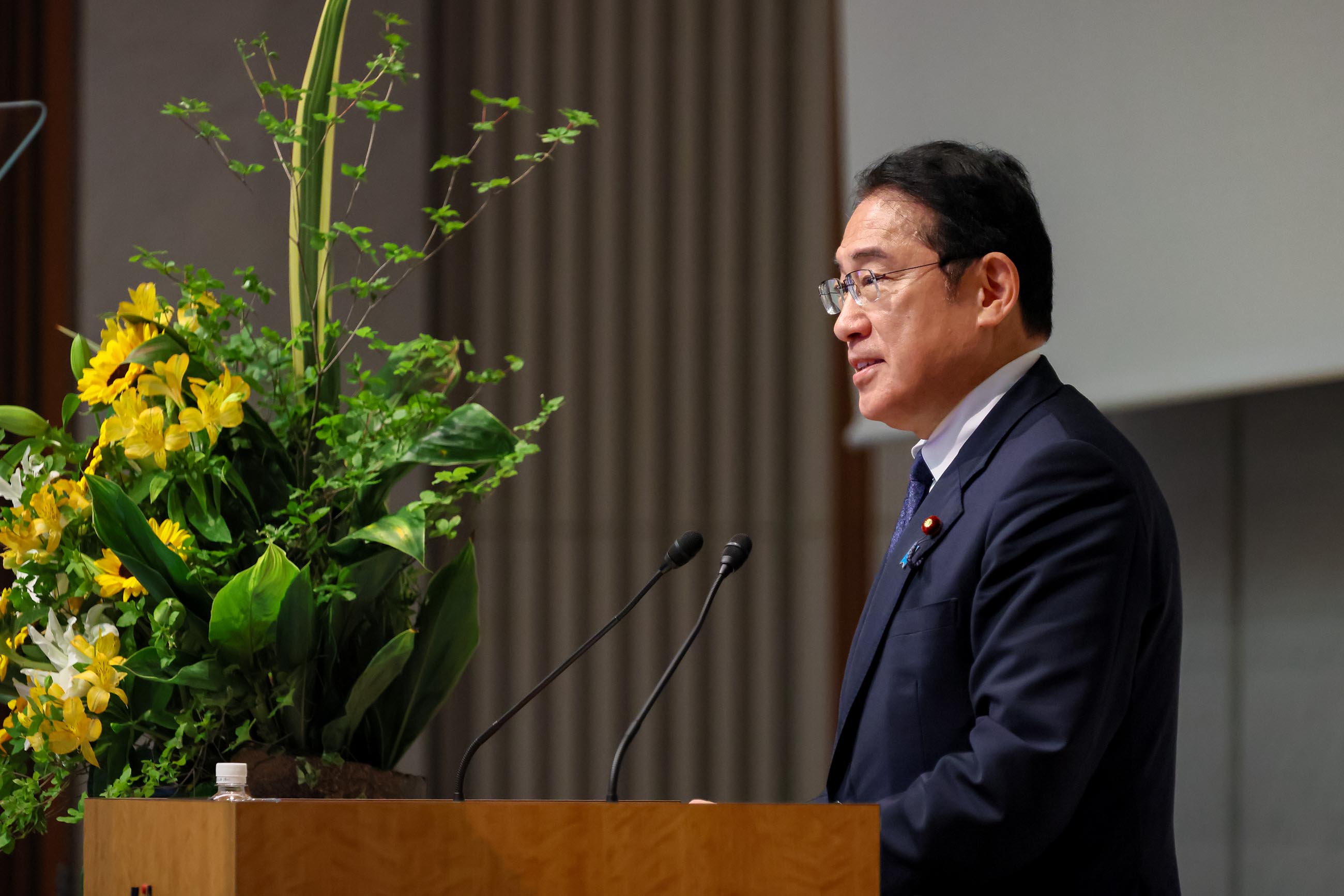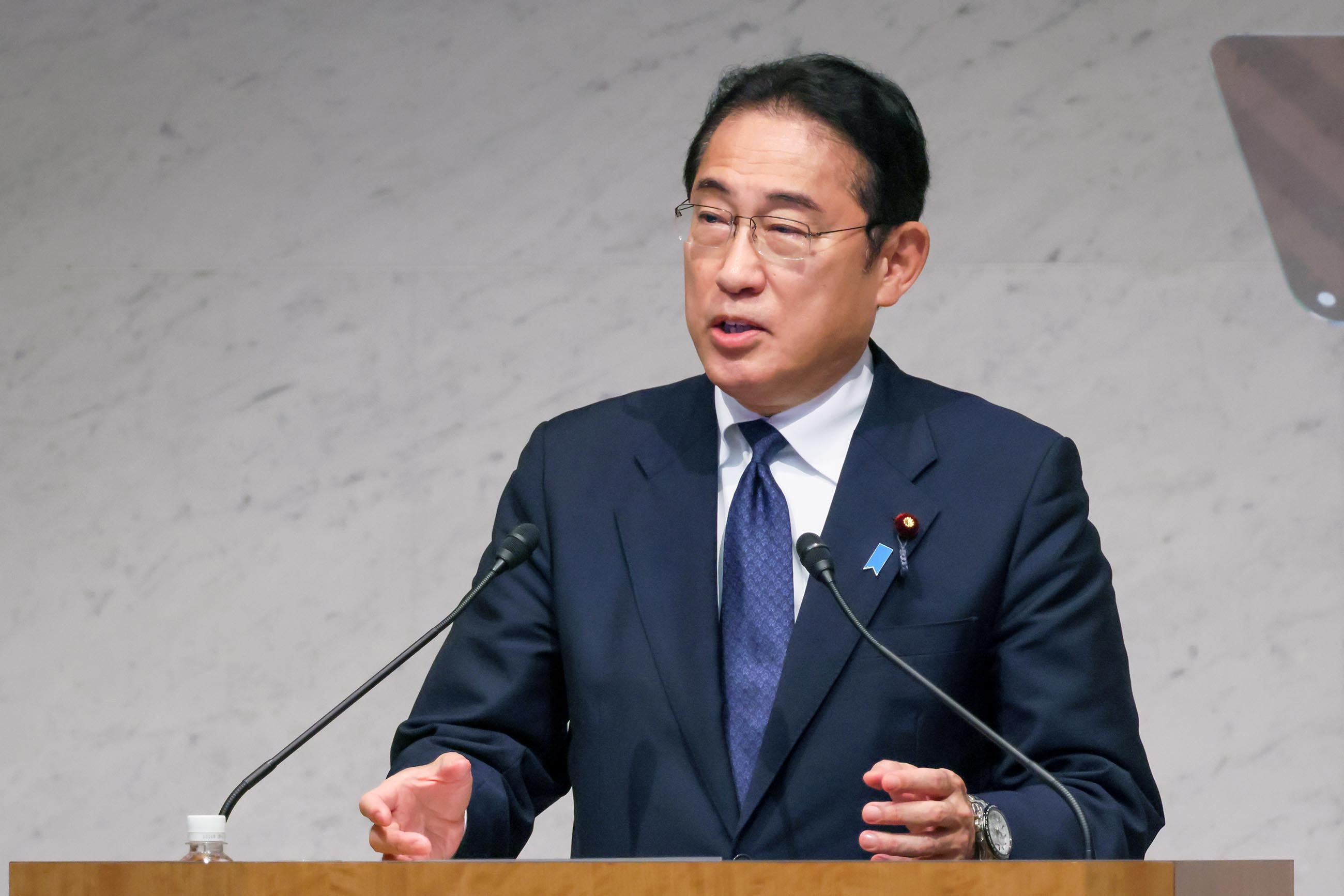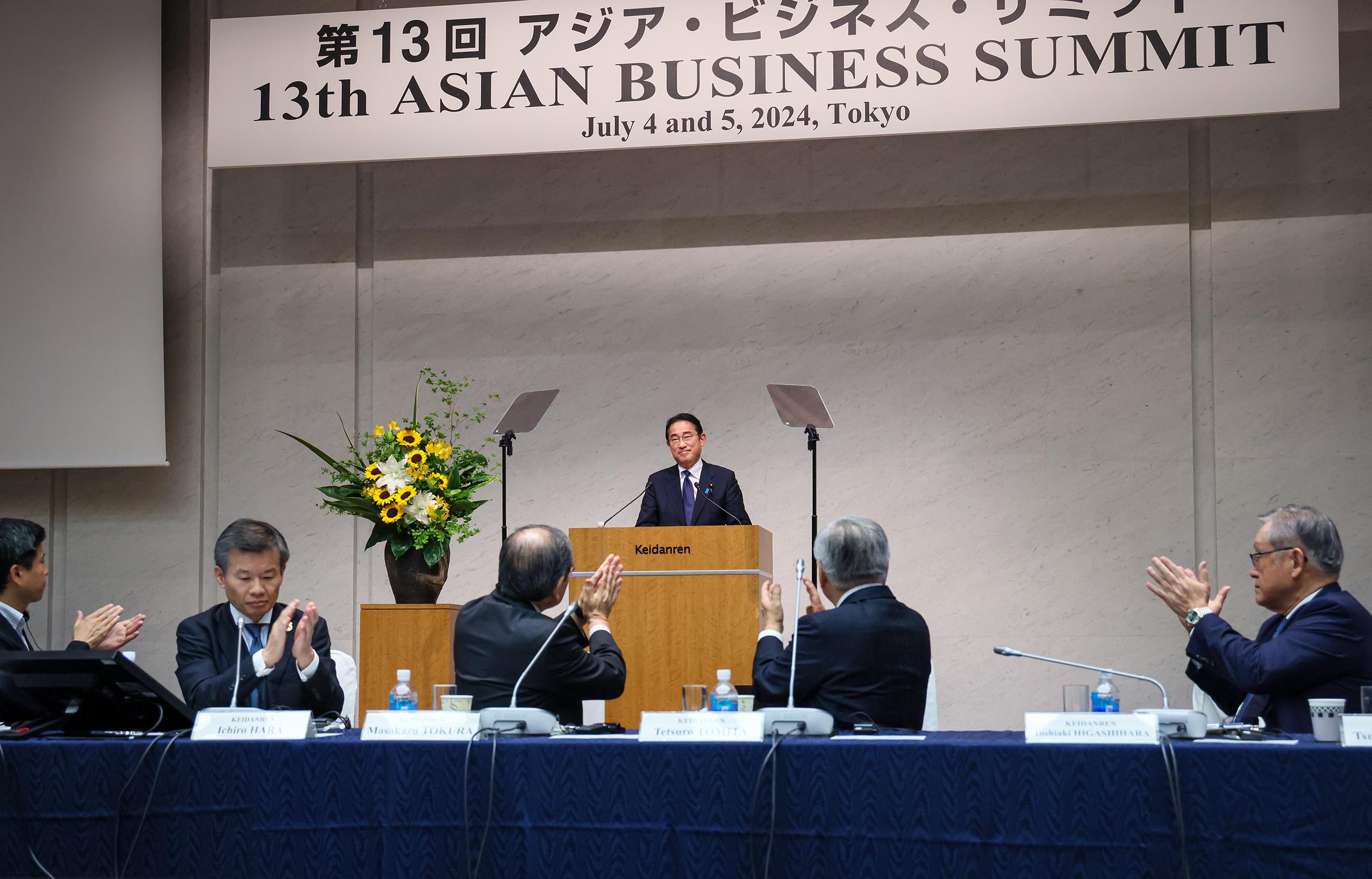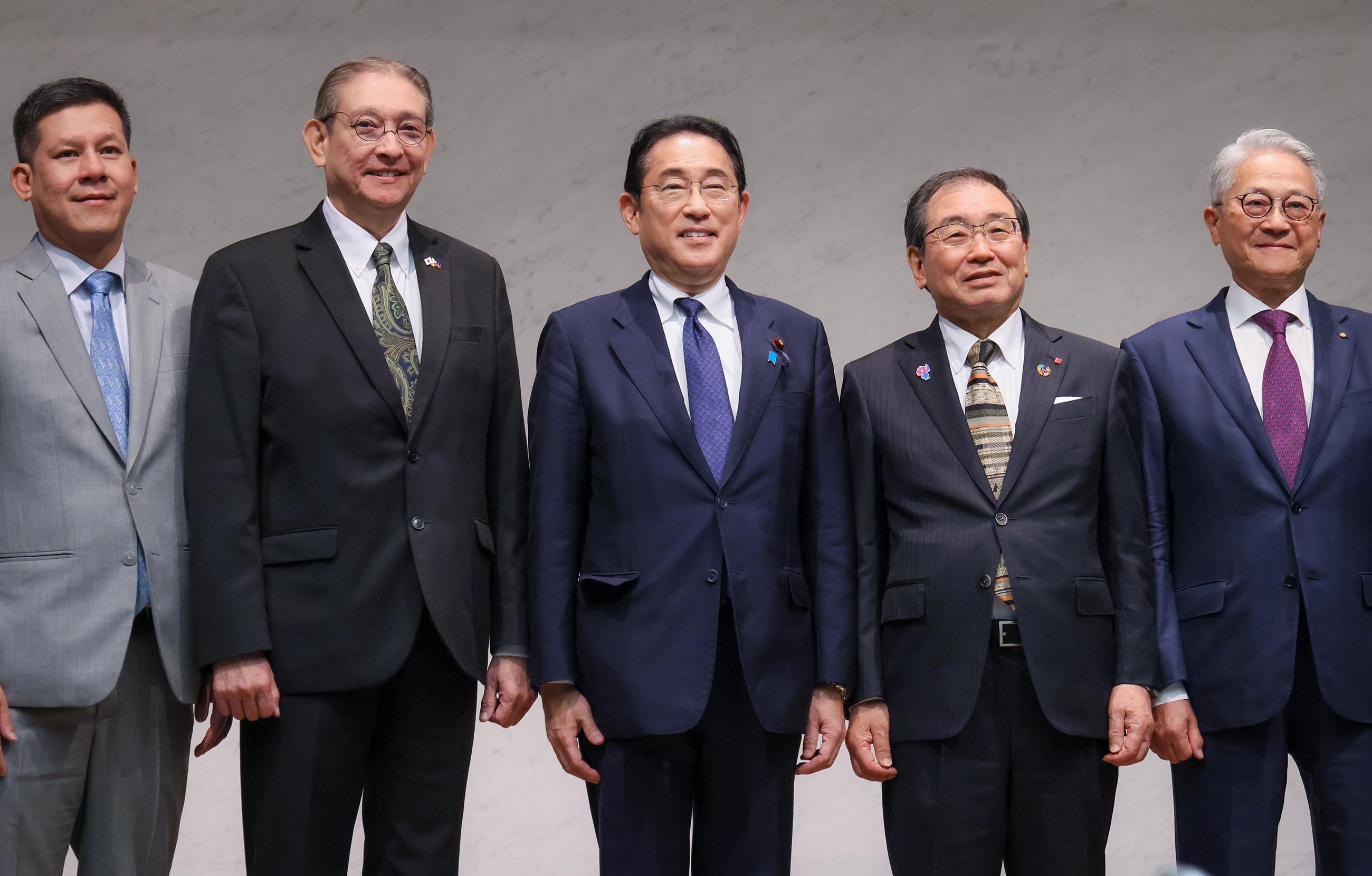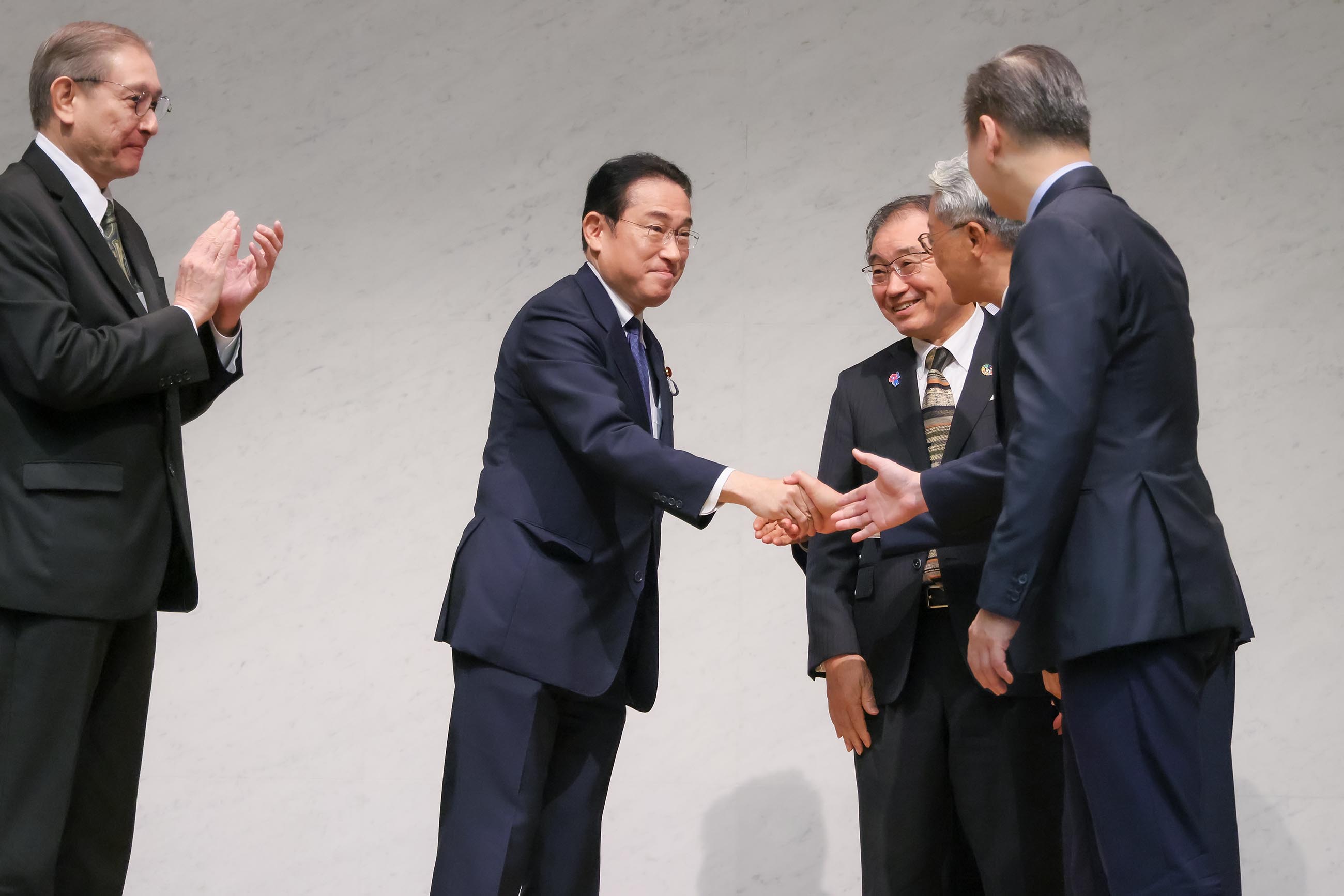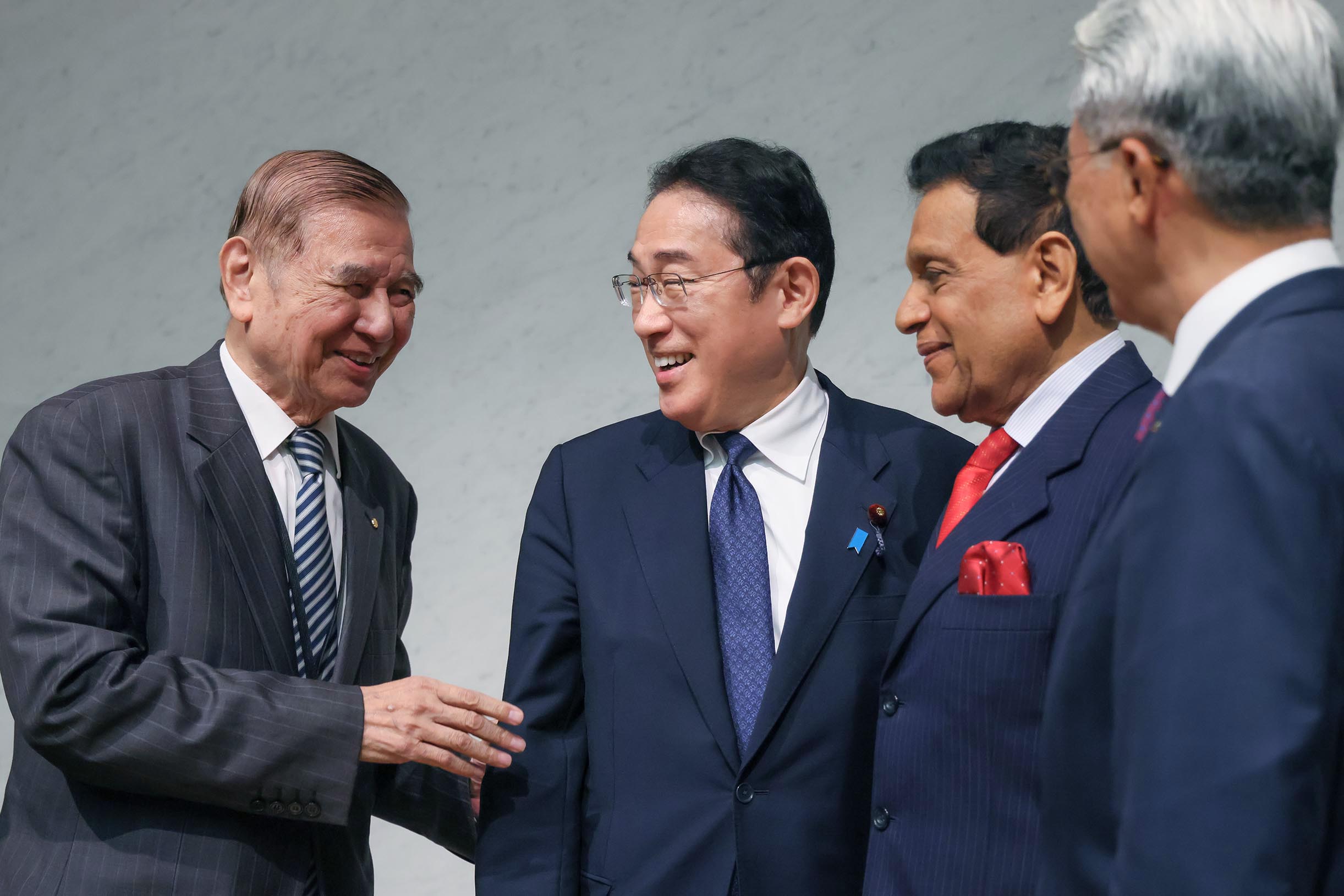Asia Business Summit
[Provisional translation]
On July 5, 2024, Prime Minister Kishida attended the 13th Asia Business Summit held in Tokyo.
Prime Minister Kishida said in his speech:
“Good afternoon, ladies and gentlemen. I am KISHIDA Fumio, Prime Minister of Japan. I extend my heartfelt congratulations on the successful holding of the Asia Business Summit today.
The Asia Business Summit was first held in Tokyo in 2010 on the initiative of the Japan Business Federation (Keidanren), and this is the 13th time that the summit has been held. And this is the first summit in Tokyo in nine years since it was last held in 2015. After overcoming the COVID-19 pandemic, we are truly pleased to welcome you on this occasion. Welcome back to Japan! I would like to reiterate my respect for Chairman Tokura, who hosts the conference, and the members of Keidanren.
The international community is now at a turning point in history – Russia’s invasion of Ukraine, rising tensions in the Middle East, and growing competition among major powers. The world is facing various crises of division and confrontation.
However, we must not bring this division and confrontation into Asia, so that this region can continue to achieve strong growth. I intend to promote efforts to make Asia a region of peace, prosperity, and cooperation in a way unique to Japan. Then what exactly is Japan going to do? Today I am going to talk about what role Japan will play from the two perspectives of green transformation (GX) and digital transformation (DX).
The first is GX. To put it in a few words, Japan will lead decarbonization of Asia and create a huge decarbonization market in the region. We would like to promote cooperation for this purpose. Decarbonization is a global challenge for which we cannot waste any time. Countries around the world are beginning to join a race to invest in the reorganization of their industrial structures to decarbonized ones. Japan has decided to promote green transformation, or GX, as a national strategy, aiming to achieve both carbon neutrality by 2050 and economic growth, and to provide upfront investment support of about 20 trillion yen over ten years to realize public and private investments of 150 trillion yen. Asian countries, especially the members of the ASEAN (Association of Southeast Asian Nations), have also set high targets for decarbonization and are about to begin efforts to achieve them. Against this background, it is crucial to attract investments in this decarbonization market, so that Asia can achieve sustained high growth going forward. Some estimate that the realization of carbon neutrality in Asia will require 4,000 trillion yen over the next decade.
Japan has seized various opportunities to make the case to the world that a variety of pathways to decarbonization are important. This is because the underlying energy and industrial structures differ from one country to another. This idea was articulated in the Leaders’ Communiqué of the G7 Hiroshima Summit, which I chaired, and has been properly passed down to last year’s COP28 (28th Conference of the Parties to the United Nations Framework Convention on Climate Change) and to this year’s G7 Summit.
Japan, which depends on fossil fuels for a large part of its electricity supply and has a manufacturing-centered industrial structure, and Asian nations, especially the ASEAN, face a very similar situation. In Asia, it is not easy to connect power grids and supply electricity to each other across the region, as in the case of Europe. That is why I believe that sharing Japan’s decarbonization experience with the rest of Asia will enable Japan and Asia to achieve both decarbonization and economic growth. As a framework to this end, we launched the Asia Zero Emission Community (AZEC) together with Indonesia and other highly ambitious Asian countries.
In January 2022, I proposed the AZEC in my first policy speech as Prime Minister. Then we held the first AZEC summit meeting in Tokyo last December. In face-to-face discussions with the leaders of Asian countries, I received many very positive comments, such as expectations for the AZEC and for Japan’s technologies and insights. I am convinced that the AZEC will serve as an engine and platform to drive decarbonization efforts in Asia.
We are making arrangements so that we can hold the second summit meeting in Laos this fall. My idea is that, if we say that last year was the inaugural year of the AZEC, this year, the second year, should be a year of agreement among the countries concerned on a concrete course of action for the next decade. To this end, I would like to make three proposals today regarding the future of the AZEC.
The first is to launch sectoral cooperation initiatives for zero emissions in the electricity, transportation, and industrial sectors.
The second is to establish an Asia Zero Emission Center at the ERIA (Economic Research Institute for ASEAN and East Asia) in Jakarta to support these initiatives in practical terms. We would like ERIA to become, so to speak, an Asian version of the OECD (Organization for Economic Co-operation and Development). With a large pool of economists, the OECD leverages its abundant data and analytical capabilities to contribute to the formulation of rules and standards in various fields. We hope that the ERIA will also become an organization that leads the AZEC in institutional aspects through the collection and analysis of data.
And the third is to develop cross-border infrastructure, including rules on Asia-wide decarbonization in the AZEC; in other words, to promote the so-called ‘whole-area’ approach.
Moving forward, Japan will continue to advance specific collaborative projects with the Global South to promote the AZEC. However, just doing so alone will not go beyond individual project-based efforts. What is important for the AZEC is to create a major decarbonization market in Asia, attracting investments and transition finance from around the world. Therefore, we would like to work on the development of common rules, such as a framework for the visualization of CO2 emissions across supply chains and rules on trading credits. In particular, we will swiftly work to develop standards to facilitate cooperation in hydrogen and carbon dioxide capture and storage (CCS). Just recently, we enacted a law to promote low-carbon hydrogen and another to promote CCS in Japan. We will share insights on these systems with Asia to bring into reality a hydrogen supply chain that extends across the region and the transportation of CO2 for cross-border CCS. The creation of a common Asian market, connected by common rules and infrastructure – this is the future that the AZEC should aim for.
Next up is DX. Today I would like to discuss how we seek to pursue innovation in DX, especially in the field of artificial intelligence (AI), together with Asia. AI is a technology that will determine industrial competitiveness and even national power itself, and competition for its development is increasingly heated around the globe.
The more data AI learns, the smarter it will become. Therefore, LLMs, or large-scale language models that utilize text data, have evolved significantly, especially in languages with more text data, such as English and Chinese. As a matter of course, we in Asia can also utilize LLMs that have learned data in English and Chinese. However, in order to reap the greatest benefits of LLMs, we should develop LLMs rooted in the rich language and culture of each country after all. Unfortunately, Japanese is a minor language in the world, and what is more, it is said to be very complex. Nevertheless, many Japanese start-ups are developing LLMs in such a minor and difficult language.
I am confident that the expertise of these Japanese AI engineers can contribute to the development of LLMs in other Asian languages. In fact, Japanese AI companies have expressed their strong desire to contribute to the region. For instance, I have heard that Japanese startup ELYZA is planning to develop a Thai-based LLM for the use in business matching between Japanese and Thai companies. The Government of Japan will provide support to give concrete shape to such efforts. In addition, we will promote collaboration between major companies in Singapore, Malaysia, Vietnam, and other Asian countries and Japanese AI companies to expand the circle of efforts.
The Government of Japan, on its part, will advocate the concept of ‘AI Innovation for Asia’ and offer robust support. I pledge that Japan will work with Asia to develop AI human resources and foster 100,000 highly skilled digital talent over the next five years. My idea is that we would like to promote the exchange of human resources between Japan and Asia both in education and business, and create a community with depth of talent in the region to advance AI innovation, while seeking to contribute to the creation of a new market targeting more than one billion people in Asia with Japanese AI technologies. Young people in Japan and Asia will work together in friendly competition to hone their skills, further advance AI technologies, and carve out the future of Asia. Let us work together to create such an era.
I would also like to mention the most important thing about AI. While AI holds great potential for the development of humanity, it also poses significant risks. At the Hiroshima G7 Summit last year, I launched the Hiroshima AI Process to push ahead with international efforts to address the risks of generative AI. Then in May, we launched the Hiroshima AI Process Friends Group with countries and regions that support the spirit of the Hiroshima AI Process, and the number of participants now stands at 53. Going forward, we intend to advance cooperation with our Asian counterparts on governance frameworks and countermeasures against technical risks to realize safe, secure, and trustworthy AI.
Today I have talked about Japan’s concrete actions to bring peace, prosperity, and cooperation to Asia, with a focus on the two themes of GX and DX. I am informed that the proposals you made today are crucial for the future of Asia, including the promotion of people-to-people exchanges, the realization of wellbeing, and the facilitation of free and fair trade and investments, in addition to GX and DX. I will read the proposals carefully. Based on these, let us continue to strive together for the future of Asia.
Lastly, I would like to mention one more point. Next year, in April 2025, the Osaka Kansai Expo will kick off in Osaka under the theme of “Designing Future Society for Our Lives.” I believe that this will be a wonderful opportunity of the fusion of Japanese and Asian cultures, so please visit the Expo.
Before closing my remarks, let me add just one more thing. Asia is now a global growth center, accounting for nearly 35 percent of the world’s GDP (gross domestic product). Nowadays, the future of Asia determines the future of the world. I have delivered this message on various occasions. It is members of the business sector, who are present here today, that support growth in Asia.
I hope that you will take advantage of today’s opportunity to further promote the development of the entire Asia. Japan will remain a good partner that grows together with you. Let me conclude my speech by renewing this pledge as the leader of the Government of Japan. Thank you very much for today.”
